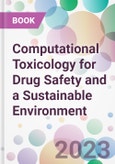List of topics:
1. Applications of computational toxicology in pharmaceuticals, environmental andindustrial practices
2. Verification, validation and sensitivity studies of computational models used in toxicologyassessment
3. Computational toxicological approaches for drug profiling and development of onlineclinical repositories
4. How to neutralize chemicals that kill environment and humans: an application ofcomputational toxicology
5. Adverse environmental impact of pharmaceutical waste and its computational assessment6. Computational aspects of organochlorine compounds: DFT study and molecular docking
calculations
7. In-silico studies of anisole and glyoxylic acid derivatives8. Computational toxicology studies of chemical compounds released from firecrackers
9. Computational nanotoxicology and its applications
Readership
Graduate and postgraduate students, academics and researchers in pharmacology, computational biology, toxicology and environmental science programs.Table of Contents
- Contents
- Foreword
- Preface
- List of Contributors
- Pharmaceuticals, Environmental and Industrial Practices
- Nidhi Singh, Seema Joshi and Jaya Pandey
- Introduction
- Applications of Computational Toxicology
- Applications of Computational Toxicology in Pharmaceuticals
- Applications of Computational Toxicology in Environmental
- Practices
- Applications of Computational Toxicology in Industrial
- Practices
- Conclusion
- Acknowledgement
- References
- Computational Models Used in Toxicology Assessment
- Viswajit Mulpuru and Nidhi Mishra
- Introduction
- Validation of Computational Models Used in Toxicology
- Assessment
- Verification of Computational Models Used in Toxicology
- Assessment
- Code Verification
- Calculation Verification
- Sensitivity Studies of Computational Models Used in Toxicology
- Assessment
- Factors Affecting Scientific Creditability
- Conclusion
- References
- Profiling and Development of Online Clinical Repositories
- Uzma Afreen, Ushna Afreen and Daraksha Bano
- Introduction
- Drug Toxicology
- Drug Profiling
- Basic Principles of Computational Toxicology Approaches
- Importance of Computational Toxicology in the Development of Novel Drug Candidates
- Computer-Based Toxicological Studies of Several Drug Candidates
- Some Important Toxicity Databases and Online Clinical Repositories for Medicinal
- Chemists
- Bindingdb
- Pubchem
- Chembl
- Toxtree
- Stitch
- Cpdb
- Osiris Property Explorer
- Gene-Tox
- Protox
- Admetsar 2.0
- Dragon
- Admetlab 2.0
- Vinampi
- Sider
- Gptips
- Derek Nexus
- Sarah Nexus
- Livertox
- Ltkb
- Gusar
- Tox21
- Chemtunes/Toxgps
- Case Ultra
- Toxnet
- Withdrawn
- Prospects of In-Silico Toxicology in Drug Development
- Conclusion
- References
- And Humans: An Application of Computational Toxicology
- Shristi Modanwal, Nidhi Mishra and Ashutosh Mishra
- Introduction
- Major Categories for in Silico Toxicology Tools
- Tools and Databases for Toxicity Prediction
- Databases
- Open Access Tools for Toxicity Prediction
- Commercially Available Tools for Toxicity Prediction
- Toxicity Testing Methods
- Structural Alerts Methods
- Physiologically Based Kinetic (Pbk)
- Read-Across and Trend Analysis
- Quantitative Structure-Activity Relationship
- Machine Learning
- Artificial Intelligence
- Conclusion
- Acknowledgments
- References
- And Its Computational Assessment
- Tuba Siddiqui, Saima Arif, Saman Raza and Tahmeena Khan
- Introduction
- Sources
- Hospital Influent and Effluent
- Household Waste
- Industrial Waste
- Aquaculture
- Human Excreta
- Manure, Slurry, Animal Husbandry and Veterinary Medicine
- Plant Agriculture Waste
- Landfills/Incineration
- Types of Pharmaceutical Waste
- Classes of Pharmaceutical Wastes
- Environmental Risk Assessment
- Identification of the Hazard
- Detection of Threshold Dose
- Calculation of Risk Quotient
- Dose and Species Extrapolation
- Characterisation of Risk
- In Silico Tools for Environmental Toxicity of Pharmaceuticals
- Sar and Qsar Studies
- Conclusion
- References
- Study and Molecular Docking Calculations
- Nikita Tiwari, Dinesh Kumar Mishra and Anil Mishra
- Introduction
- Methods and Materials
- Quantum Chemical Calculations
- Protein Preparation and Molecular Docking
- Results and Discussion
- Dft Calculations Studies
- Thermodynamic Properties
- Molecular Orbital Properties
- Molecular Electrostatic Potential (Mep)
- Binding Affinity and Binding Interactions Analysis
- Conclusion
- Acknowledgements
- References
- Derivatives by Computational Methods
- Sakshi Gupta and Seema Joshi
- Introduction
- Softawares
- Gaussian Program
- Orca
- Multiwfn
- Veda
- Chimera
- Autodock Vina
- Origin
- Adme
- Computational Studies With Glyoxylic Acid Derivatives
- Purpose of the Work
- Toxic Effects of Mopa and Pga Derivatives
- Health Hazard Information for Anisole Derivatives
- Short-Term Health Effects
- Long-Term Health Effects
- Cancer Risk
- Reproductive Risk
- Other Long-Term Effects
- Health Hazard Information for Glyoxylic Acid Derivatives
- Computational Study
- Experimental Details
- Results and Discussion
- Optimized Molecular Geometry
- Population Analysis
- Drug Likeness
- Fmo
- Molecular Docking Studies
- Applications
- Time and Cost Cutting
- Pharmaceutical Formulations
- Data Generation
- Toxicity Forecasting
- Conclusion
- References
- Released from Firecrackers
- Alfred J. Lawrence, Nikita Tiwari and Tahmeena Khan
- Introduction
- Categories of Firecrackers and Regulations Associated With
- Firecrackers
- Chemistry of Fireworks
- Major Chemical Constituents/Chemical Composition of Fireworks
- Fuels
- Oxidizers
- Colours
- Reducing Agents
- Regulators
- Binders
- Significance of Computational Toxicology Studies
- Molecular Docking for Binding Studies
- Evaluation of Binding Energetics
- Molecular Dynamics (Md) Simulations
- Interaction of Potent Pollutants Emitted from Fireworks and Their Interaction With Human
- Proteins: a Case Study
- Results and Discussion
- Docking Results With Estrogen-Related Receptor Gamma (Err-Gamma or Errγ) Protein
- Docking Results for Human Serum Albumin Protein
- Docking Results With Superoxide Dismutase
- Molecular Dynamics Simulation Studies
- Root Mean Square Deviation (Rmsd)
- Root Mean Square Fluctuation (Rmsf)
- Solvent Accessible Surface Area (Sasa)
- The Radius of Gyration (Rg)
Author
- Tahmeena Khan
- Saman Raza








